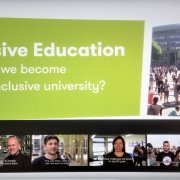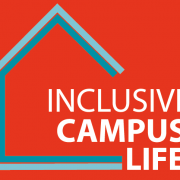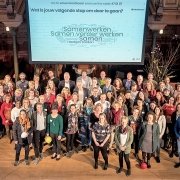Studieren Probieren (Trying out studies)
Excerpt
Studieren Probieren is offered by the Austrian National Union of Students, the Österreichische Hochschüler_innenschaft, which allows individuals interested in taking up studies to get a sneak preview of their subject of choice. It allows them to attend a lesson (as visitor) with a current student in the subject area and then discuss their experience with the student face to face at the end of the lesson. The aim of the initiative is to give those interested in taking up studies an opportunity to experience the subject area they are interested in so that they can see what studies at a higher education institution is like through firsthand experience, and support this through peer guidance by a student who is currently studying the same subject. In this way, the initiative seeks to guide those interested in taking up studies in their decision making.
The initiative exists since 2009 and site visits are possible in a wide variety of subject areas and at about 40 higher education institutions across Austria, including universities, universities of applied sciences and higher education institutions in the field of pedagogy.
Narrative, origins and objectives of the initiative
What kind of project is this? Please give a short description (summary) of it.
Studieren Probieren is an offer of the Austrian National Union of Students, the Österreichische Hochschüler_innenschaft, which allows individuals interested in taking up studies to get a sneak preview of their subject of choice. It allows them to attend a lesson (as visitor) with a current student in the subject area and then discuss their experience with the student face to face at the end of the lesson. The aim of the initiative is to give those interested in taking up studies an opportunity to experience the subject area they are interested in so that they can see what studies at a higher education institution is like through firsthand experience, and support this through peer guidance by a student who is currently studying the same subject. In this way, the initiative seeks to guide those interested in taking up studies in their decision making.
The initiative exists since 2009 and site visits are possible in a wide variety of subject areas and at about 40 higher education institutions across Austria, including universities, universities of applied sciences and higher education institutions in the field of pedagogy.
Please tell us why, in general, this project is considered a successful one?
The project is not limited to only one higher education institution or few subject areas, but covers a wide spectrum of subject areas and higher education institutions. As such the project is very comprehensive and offers interested individuals a wide spectrum to choose from. With the possibility of experiencing a regular lesson of the subject area of choice it also gives interested individuals a realistic experience of what studying in their preferred field or higher education institution would be like, which is important in order to make informed decisions. The peer support by current students allows the participants / prospective students to raise any questions or concerns they may have with someone their age who may have recently encountered similar difficulties in making decisions about their future studies. The success of the initiative also seems to be evidenced by the several thousand applications received by the Austrian National Union of Students annually.
And why would you consider it a grass-roots initiative?
The project has been initiated by the Austrian National Union of Students. As such it is an initiative from students for prospective students. It is, therefore, not only a grassroots initiative, but also an initiative based on peer support.
What challenges needed to be solved in this project?
During the first four years of the programme (2009/2010 - 2013/2014) all events offered by student mentors could be offered as there was sufficient funding to compensate all student mentors for their time. In the academic year 2014/2015 more events were offered by student mentors, which led to increased participation. However, the original allocated budget for compensating mentors was not enough anymore. The Austrian National Union of Students covered the budget shortfall out of their own budget. As a result, events have to be more carefully selected now to ensure that they fit within the allocated budget for the initiative (Žitňanský 2017: 66).
Is this initiative based on any particular theoretical framework? Which one?
According to Yorke (1997) (as cited by Žitňanský 2017) the five most significant reasons for student drop-out are that the higher education institution is not a good fit; the student is not feeling well prepared for the higher education experience; a lack of commitment to the course; financial hardship or poor academic progress. The initiative seeks to address the first three issues, namely to support prospective students in making informed choices about the higher education institution, the programme and feeling better prepared for studying in higher education in general. It does so based on a concept of peer guidance.
(Appendix) Is your intervention standing on its own or is it a part of a bigger and more holistic approach?
The initiative is just one of a number of projects carried out by the Austrian National Union of Students, such as a website maintained by them called “Studienplattform.at” (https://www.studienplattform.at/), which allows interested individuals to search relevant programmes of study by field of study, higher education institution or city. Žitňanský (2017) also informs that the website of Studieren Probieren is integrated with “Studienplattform.at”, so that students searching for a particular study programme at a particular institution will also see available events of student mentors of Studieren Probieren. If they are interested to join and click on the event, they are directed to the platform of Studieren Probieren where they can register.
Moreover, the Austrian National Union of Student offers counselling specifically targeted at students in upper secondary education to guide them in their choice of study (https://www.oeh.ac.at/en/referate/guidance-counselling-students-and-prospective-students).
Please describe the group(s) intended as beneficiaries of this initiative
Why has this group (have these groups) been chosen?
The project is not limited to any particular groups, but is open to all individuals interested in studying, for example school students, students, workers and those undertaking their compulsory service in the military. The issue of student guidance has been chosen in view of the high share of student drop-out or transfer in Austria.
Could you please tell us something about the relative size of the (of each) target group, within the school/university population, region and/or country?
In Austria about 52.5% of students who started their initial programme of studies quit, failed or transferred to another programme (Universitätsbericht 2014 as cited by Žitňanský 2017). Thaler and Unger (2014) (as cited by Žitňanský 2017) argue that about 38% of these students did not actually drop out, they remained in higher education, returned later on or where international exchange students. Nevertheless, the high share of students dropping out (temporarily or permanently) or transferring to other studies is evidence that students’ experiences of higher education are not matching their expectations, which goes to show that decisions about undertaking studies in higher education are made based on a lack of information. It is, therefore, important to provide prospective students with realistic, firsthand experiences of student life in higher education and in particular insights into the content and expectations in their desired field of study.
Which social characteristics are taken into account and what is the geographical area covered?
No particular social characteristics are taken into account, since the initiative is open to all those interested in taking up studies. Site visits are possible at about 40 higher education institutions across Austria, including universities, universities of applied sciences and higher education institutions in the field of pedagogy. The initiative, therefore, covers all of Austria.
On which level is the project implemented?
The project is implemented at the level of the higher education institution of the student mentors volunteering to take interested individuals to a lesson in their chosen field of study. It is coordinated at national level by the Austrian National Union of Students.
Please describe the political and socio-economic factors that you believe have been important enablers for your initiative
Did the initiative have political support?
Studieren Probieren is funded by the Austrian Federal Ministry of Education, Science and Research and is named as a top priority to minimize dropouts and changes of study.
How did it fit with local, regional or national policies?
Who are the stakeholders supporting the initiative?
The project was initiated by the Austrian National Union of Students. It is supported by current students (the student mentors) volunteering to take interested individuals with them to one of their lessons and providing one-on-one guidance after the lesson. It is also supported by teachers in secondary schools, who provide information on the project to their students so that they can benefit from it. Moreover, different higher education institutions support the project by promoting it on their websites.
Are there particular demographic changes present that are influencing the project?
With reference to Unger, Žitňanský (2017) it shows that the number of students in higher education in Austria has grown significantly in the past decades with over half of an age group entering higher education now. This is supported both by the access to higher education being mostly free of charge and admission requirements to higher education being publicly regulated.
What is the institutional strategy and culture of the (educational) organization?
The Austrian National Union of Students represents the interests of all students in higher education in Austria. It represents their political interests to higher education institutions, policy makers and any other stakeholders at local, national and international level. It also provides guidance and support to (prospective) students to empower them to take up, undertake and complete their studies and tackle any obstacles they may be facing. As such, providing guidance to individuals to make informed decisions about their studies is fits into the offering of the Austrian National Union of Students.
To what extent does the initiative have an influence on institutional policy (or potential influence) of the (educational) organization?
(Appendix) Is there public support for your initiative and the issue it addresses?
Yes, Studieren Probieren is funded by the Austrian Federal Ministry of Education, Science and Research and is considered a top priority for minimizing dropouts and changes of study programme.
With the same reasoning, the Austrian government initiated a programme called 18plus Berufs- und Studienchecker (Checking jobs and studies), which is offered at upper secondary schools to support young people in making informed decisions about their career and educational pathways. Studieren Probieren is one initiative that forms part of this programme package. While schools do not have to take part in the programme, they do have to address the issue of career and study pathways in their curricula in some way. During the academic year 2016/2017, about 60% of Austrian upper secondary schools (a total of 386 schools) participated in 18plus.
(Appendix) What other factors do you think have been important for the success of this initiative?
Please describe the overall initiative design and the methods and tools used to reach the goals
Please describe the specific activities carried out.
The project offers interested individuals the opportunity to experience a lesson in their subject area of choice. They accompany a current student (the student mentor) in that subject area to the lesson. At the end of the lesson, they have the opportunity to discuss anything with the student mentor and receive guidance and support from them. To this end, current students register their willingness to be a student mentor and take interested individuals to a lesson in their field of study. Interested individuals in turn may register for any number of sessions they are interested to attend. The Austrian National Union of Students administers the applications from interested individuals and matches them with available sessions of student mentors. The student mentors receive an expense allowance (34€) per event. There is no fee whatsoever for the participants.
What were the key roles (teacher, student, management team etc.) within the project?
The project is promoted by teachers in secondary schools, who inform students about the project and the possibility to gain firsthand experience of their subject area of choice in a normal lesson at a higher education institution.
Lecturers in higher education support the project by allowing interested individuals to join a lesson together with their student mentor. Depending on the subject area and the type of lesson the possibility for an interested individual to join may be limited.
Besides that, the project relies heavily on current students willing to act as student mentors to interested individuals, allowing them to join a lesson with them and providing guidance and support following the lesson.
What ideas, tools, theories, models, methodology (etc.) have been used to reach the goals?
What are the final revenues of the project?
Please describe if your project ensured its sustainability
If so, how did you ensure the short-term impact of the project?
Participants receive a questionnaire after the events to ensure the quality of the project. The return rate to the evaluation form is consistent at 40% or higher. This is aided by the incentive of having the opportunity to win one of five vouchers for the online shop www.thalia.at, as well as the sending of two reminders to those who did not complete the evaluation form.
And how did you ensure the long-term impact of the project?
Has your project been replicated elsewhere?
Please tell us about the resources used in this initiative
What was the budget for the initiative?
70.000€ per year
How much did the initiative depend on volunteers?
The project depends heavily on current students volunteering as student mentors to take interested individuals to a lesson in their field of study and provide one-on-one support after the lesson. Žitňanský (2017) shows in his Master thesis that the quality of the programme depends heavily on the student mentors, which means they are a very important element of the project. The success of the project is evidenced by the fact that a number of former beneficiaries of Studieren Probieren are now acting themselves as student mentors in the project to support prospective students in their decision making.
How were the costs perceived by the public/the sector/other stakeholders?
To what extent did the initiative achieve its objectives?
Please describe the evidence to support the success of your initiative.
The Austrian National Union of Students receives thousands of applications annually from interested individuals wishing to visit lessons in their subject area of choice. In some cases the demand can outweigh the availability of places / lessons with student mentors. In those cases, interested individuals are placed on waiting lists and offered the opportunity to join a lesson in their chosen subject area when it becomes available.
Did the intervention lead to any unintended (positive) outcomes?
One unexpected positive outcome is that there is a growing number of student mentors who were previously participants of Studieren Probieren.
Another positive and unexpected outcome was the demand from prospective students and student mentors. For the first four years (2009/2010-2013/2014) the initiative was still relatively new and all events offered by student mentors could be funded. However, suddenly the initiative became more well-known and demand increased, which outweighed the available budget for the initiative. Now, all events are carefully selected to ensure that they fit within the budget of the initiative (Žitňanský 2017: 66).
What indicators (quantitative and qualitative) have you measured to demonstrate success?
Latest figures from 2016/2017: (n= 1685) show that:
- 85% of the participants rate Studieren Probieren as very helpful for their choice of studies
- 96% of the participants would recommend Studieren Probieren
- There is a growing number of events every year: 136 in 2010/11 to 919 in 2016/2017, and
- A high demand by participants to offer more events
Žitňanský (2017) also provides details on the use of event capacity. Almost half of the events offered by student mentors in 2015/2016 were either fully booked or overbooked. A little more than half of the events still had capacity to accommodate interested prospective students, but available capacity decreased compared to the academic year 2014/2015, which suggests an efficient use of resources (Žitňanský 2017: 67). Žitňanský (2017: 91-92) also provides some insights into the qualitative feedback received by participants.
(Appendix) How did you evaluate/monitor this intervention?
The growing interest in the project is evidenced by the thousands of applications received by interested individuals wishing to visit a lesson in their subject area of choice, as well as the fact that the Austrian National Union of Students receives more requests from both current students wishing to be student mentors and prospective students wishing to attend events than they have budget for the initiative.
Besides that, evaluation forms sent to all participants as well as the Master thesis by Žitňanský (2017) serve as solid basis for a well-rounded evaluation of the initiative.


 Interkulturelles Mentoring
Interkulturelles Mentoring

 Caritas Wien/Stefanie Starz
Caritas Wien/Stefanie Starz



